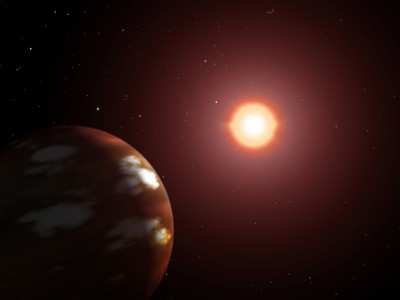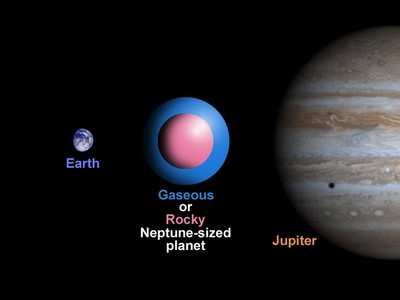Scientists Discover First of a New Class of Extrasolar
Planets
Astronomers announced today the first discovery of a new class
of planets beyond our solar system about 10 to 20 times the size of
Earth - far smaller than any previously detected. The planets make
up a new class of Neptune-sized extrasolar planets.

In addition, one of the new planets joins three others around
the nearby star 55 Cancri to form the first known four-planet
system.
The discoveries consist of two new planets. They were discovered
by the world renowned planet-hunting team of Drs. Paul Butler and
Geoffrey Marcy of the Carnegie Institute of Washington and
University of California, Berkeley, respectively; and Barbara
McArthur of the University of Texas, Austin. Both findings were
peer-reviewed and accepted for future publication in the
Astrophysical Journal. NASA and the National Science Foundation
funded the research.
"NASA, along with our partner NSF, is extremely proud of this
significant planetary discovery," said Al Diaz, Associate
Administrator of NASA's Science Mission Directorate. "The outcome
of the tremendous work of the project scientists is a shining
example of the value of space exploration."
"These Neptune-sized planets prove that Jupiter-sized, gas
giants aren't the only planets out there," Marcy said. Butler
added, "We are beginning to see smaller and smaller planets.
Earth-like planets are the next destination."
Future NASA planet-hunting missions, including Kepler, the Space
Interferometry Mission and the Terrestrial Planet Finder, will seek
such Earth-like planets. Nearly 140 extrasolar planets have been
discovered.
Both of the new planets stick very close to their parent stars,
whipping around them in a matter of days. The first planet,
discovered by Marcy and Butler, circles a small star called Gliese
436 about every two-and-one-half days at just a small fraction of
the distance between Earth and the Sun, or 4.1 million kilometers
(2.6 million miles). This planet is only the second known to orbit
an M dwarf, a type of low-mass star four-tenths the size of our own
sun. Gliese 436 is located in our galactic backyard, 30 light-years
away in the constellation Leo.
The second planet, found by McArthur, speeds around 55 Cancri in
just under three days, also at a fraction of the distance between
Earth and the sun, at approximately 5.6 million kilometers (3.5
million miles). Three larger planets also revolve around the star
every 15, 44 and 4,520 days, respectively. Marcy and Butler
discovered the outermost of these in 2002. It is still the only
known Jupiter-like gas giant to reside as far away from its star as
our own Jupiter. The 55 Cancri is about 5 billion years old, a bit
lighter than the sun, and is located 41 light-years away in the
constellation Cancer. "55 Cancri is a premier laboratory for the
study of planetary system formation and evolution," McArthur
said.
Because the new planets are smaller than Jupiter, it is possible
they are made of rock, or rock and ice, rather than gas. According
to the scientists, the planets may have, like Earth, formed through
gradual accumulation of rocky bodies. "A planet of Neptune's size
may not have enough mass to hold onto gas, but at this point we
don't know," Butler said.

Both discoveries were made using the "radial velocity"
technique, in which a planet's gravitational tug is detected by the
wobble it produces in the parent star. Butler, Marcy and
collaborators, including Dr. Deborah Fischer of San Francisco State
University and Dr. Steven Vogt of the University of California,
Santa Cruz, discovered their "Neptune" after careful observation of
950 nearby stars with the W.M. Keck Observatory in Mauna Kea,
Hawaii. They were able to spot such a relatively small planet,
because the star it tugs on is small and more susceptible to
wobbling.
McArthur and collaborators Drs. Michael Endl, William Cochran
and Fritz Benedict of the University of Texas discovered their
"Neptune" after obtaining over 100 observations of 55 Cancri from
the Hobby-Eberly Telescope at McDonald Observatory in West Texas.
Combining this data with past data from Marcy, Fischer and Butler
from the Lick Observatory in California, and archival data from
NASA's Hubble Space Telescope, the team was able to model the orbit
of 55 Cancri's outer planet. This, in turn, allowed them to clearly
see the orbits of the other three inner planets, including the new
Neptune-sized one.
 Classic Aero-TV: In Praise of Alabamas Patriot Aircraft USA
Classic Aero-TV: In Praise of Alabamas Patriot Aircraft USA NTSB Final Report: Cirrus Design Corp SR22
NTSB Final Report: Cirrus Design Corp SR22 ANN's Daily Aero-Term (12.21.25): Dead Reckoning
ANN's Daily Aero-Term (12.21.25): Dead Reckoning ANN's Daily Aero-Linx (12.21.25)
ANN's Daily Aero-Linx (12.21.25) Aero-News: Quote of the Day (12.21.25)
Aero-News: Quote of the Day (12.21.25)




